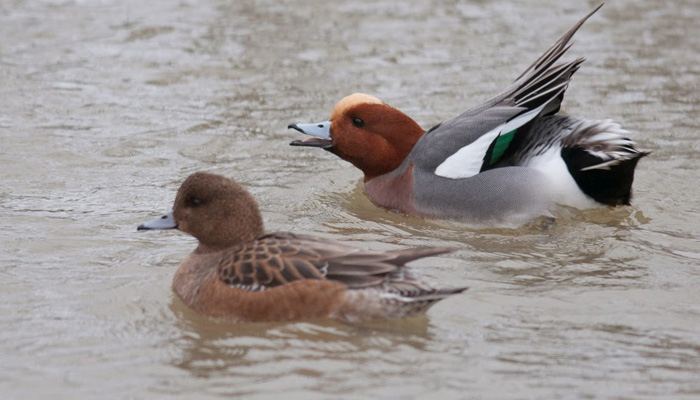
English: Eurasian Wigeon, European Wigeon
Russian: Свиязь
German: Pfeifente
French: Canard
siffleur
Mongolian: Зээрд нугас
Japanese: ヒドリガモ (Hidori-gamo)
Body length: 42-50 cm
Wing span:
71-85 cm
Breeding season: May-September
Egg number: 7-8 (occasionally 6-10)
Egg color:
Creamy-white
Brood: 1 per year
Global status: Least Concern
Regional status: Least Concern
Habitat: Breeds on boreal forest lakes and marshes, tundra pools,
also on temperate shallow fresh waters. Migratory in N,
wintering largely in marine habitats, also lakes and reservoirs. Gregarious
except when nesting. Vegetarian; often grazes on arable fields in winter.
Identification:
Medium-sized, short-necked, with rounded, comparatively large head, small bill
and pointed tail. In flight, these characters apparent as well as narrow neck,
pointed wings, and outer wing generally swept back. Flight fast. In all
plumages, note distinct white belly patch. Axillaries and underwing-coverts
dusky pale grey.
- Adult
♂ breeding: Unmistakable; head and neck chestnut, forehead and crown
creamy-yellow, breast greyish-pink, rest of body grey with white and black
stern. In flight, large white patch on upper forewing striking, speculum green.
- Adult
♀: Rather dull rufous-brown or greyish (some variation, with inclination towards
two morphs) with variable diffuse mottling and blotching (some are rather
plain), best recognized by; rather dark plumage; shape; small, pale blue-grey
bill with black tip; and contrasting white belly. Speculum dull, dark;
innermost secondaries usually edged pale, forming narrow whitish patch
(recalling 1st year ♀ Gadwall)
- Adult
♂ eclipse: Resembles adult ♀ but retains white upper forewing, and plumage more
rufous-tinged.
- Juvenile:
As adult ♀, but white underparts often faintly mottled, and speculum still
duller. 1st year ♂: As adult ♂ breeding, but upper forewing is chiefly grey-brown,
not largely pure white.
Food: Green plants in wet meadows, marshy
areas with short vegetation.